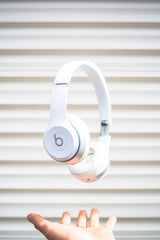Disposable Headphone Covers Vs Reusable Ones

Many of us take our headphones for granted: we put them on our ears and crack on with our day. We use them for listening to playlists and podcasts or to hear the audio on the movies or TV shows we watch from our devices.
We wear headphones when we’re playing video games or when we’re working out and we wear noise-cancelling headphones just to create a quiet space to work in.
But we may need to add headphone protection to our earcups.
There are several reasons why this is a good idea. We’ll go into more detail below, but if you’re hoping to wear headphones hygienically, then you may be caught deciding between the two main types available: disposable headphone covers Vs reusable ones.
Why People Use Protective Covers for Headphones
Headphones may sometimes need to be shared between several people. It’s always more hygienic if each person has a protective cover to use.
You may already have seen this in museums using audio guides or during tours of buildings or places of historic or cultural interest. If you’ve visited an exhibition or event with demonstrations or interactive areas, you may have put headphones on that had protective covers. You may have felt reassured by this.
Protective covers are also often worn to stop sweat or moisture from damaging the headphone cushion. This is particularly important to people who regularly workout in over-ear or on-ear headphones. It’s also popular with gamers who may play for several hours at a time.
Headphone protection covers are useful, too, if you wear make-up or tinted moisturisers and cosmetics on your face as it prevents stains from forming on the cushions.
Protective covers can be used even when the headphones aren’t in use. White earpads are particularly vulnerable to UV damage and if left in the sunlight may start turning yellow.
Some people wear headphone covers to add a splash of colour or an interesting design to their headphones. This will save paying money for more permanent alterations to the design or adding a fresh skin to the frame.
What are headphone covers?
Headphone covers are small sleeves of material that slip over the headphone cushion.
You can buy disposable ones often made of thin cotton or reusable ones manufactured from synthetic materials like spandex and lycra to wick moisture away from the headphone and also to encourage a closer fit.
Disposable Headphone Covers Vs Reusable Ones: Which is Better
There’s no right or wrong answer for everyone. Both have their advantages and it will depend on what you need headphone protection for.
Disposable headphones: Pros and Cons
- Disposable headphone covers are for when you have a lot of people sharing a single set of headphones. This could be if you’re using them in a public setting. For example, you’re showing a film throughout the day at a museum or event or if you’re promoting a product at an exhibition.
- They’re also suitable if you’re selling the headphones as a physical product and want to encourage people to try them on.
- Disposable headphone covers are cheap to buy in bulk and can be useful for employees who share headphones on a day-to-day basis with other workers or other shifts. For example, in a call centre or a hospital or classroom.
- They can be used in any scenario where headphone protection is needed quickly. There’s no need to wash them afterwards which helps them maintain their hygiene. Disposable covers are often met with relief from users precisely because they’re designed to only be used once. It makes people more likely to put communal headphones on.
- They’re light enough to allow audio to pass through, as usual, providing no distortion to the listener.
- They’re easy to store and easy to reorder as necessary.
Cons:
- They’re not at all great for the environment
- They’re suited more for mass use and less suitable for individuals
- One-size means it can be uncomfortable to wear
- Cotton is breathable but it also retains moisture so it’s not ideal for anyone likely to be sweating when wearing them.
- They make headphones look very unattractive and as most headphones are manufactured in darker colours, it means the white covers really stand out.
Reusable Headphone Covers: Pros and Cons
- For individuals, they’re far less expensive in the long-term
- They can be sized more accurately to headphones
- They’re much better for the environment as they are machine washable and can be worn again and again.
- As they’re made from moisture-wicking fabric, they’re ideal for wearing during a workout or a gaming marathon.
- They will protect against sweat damage which leaves headphone earpads flaking, peeling and smelling terrible.
- They’re a great way to add bold designs or colours to your earpads.
- They make great gifts.
- Buy a pair of reusable headphone covers from GymHugz and £1 from your sale will be donated to the Mental Health Foundation.
When looking at disposable headphone covers Vs reusable ones, it’s important to think about the reasons you need to wear them. If you’re a company and you need to protect employees and visitors quickly and easily, you might prefer disposable ones.
Small businesses looking to buy headphone covers for permanent members of staff or for anyone wanting headphone protection during a workout or gaming (or whatever, really) will find reusable ones more suitable and affordable.
GymHugz has reusable headphone covers on its website that we think you’re going to love.
Check them out before the new designs sell out.






